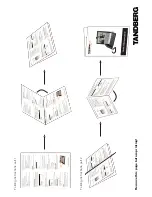
Company Confidential
s
Com
Copyright 2005© Siemens AG
Page
14
of
53
TD_Repair_L2.5_A70_A75_R1.0.pdf Release
1.0
Matrix to calculate the TX and RX frequencies A70/A75:
Band
RX / TX
Channels RF frequencies
LO1 frequency
IF freq.
EGSM 900 Receive: 0..124
935,0 - 959,8 MHz
LO1 = 4*RF
EGSM 900 Transmit: 0..124
890,0 - 914,8 MHz
LO1 = 4*(RF+IF) 80,0 MHz
EGSM 900 Receive: 975..1023 925,2 - 934,8 MHz
LO1 = 4*RF
EGSM 900 Transmit: 975..1023 880,2 - 889,8 MHz
LO1 = 4*(RF+IF) 82,0 MHz
GSM 1800 Receive: 512..661
1805,2 - 1835,0 MHz LO1 = 2*RF
GSM 1800 Transmit: 512..661
1710,2 - 1740,0 MHz LO1 = 2*(RF+IF) 80,0 MHz
GSM 1800 Receive: 661..885
1835,0 - 1879,8 MHz LO1 = 2*RF
GSM 1800 Transmit: 661..885
1740,0 - 1784,8 MHz LO1 = 2*(RF+IF) 82,0 MHz
GSM 1900 Receive: 512..810
1930,2 - 1989,8 MHz LO1 = 2*RF
GSM 1900 Transmit: 512..810
1850,2 - 1909,8 MHz LO1 = 2*(RF+IF) 80,0 MHz
Synthesizer: LO2
The second local oscillator (LO2) consists of a PLL and VCO inside Bright (
D903
) and an
internal loop filter. Due to the direct conversion receiver architecture, the LO2 is only used for
transmit-operation. The LO2 covers a frequency range of at least 16 MHz (640MHz –
656MHz).
Before the LO2-signal gets to the modulator it is divided by 8. So the resulting TX-IF
frequencies are 80/82 MHz (dependent on the channel and band). The LO2 PLL and power-
up of the VCO is controlled via the tree-wire-bus of Bright (EGOLDLite signals
RF_DAT
;
RF_CLK
;
RF_STR
). To ensure the frequency stability, the 640MHz VCO signal is compared
by the phase detector of the 2
nd
PLL with the 26Mhz reference signal. The resulting control
signal passes the external loop filter and is used to control the 640/656MHz VCO.
The required voltage
VDD_BRIGHT
is provided by the ASIC
D361















































